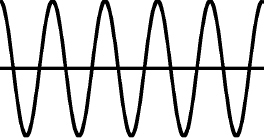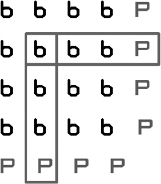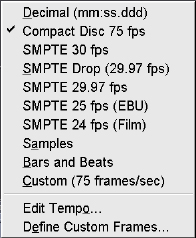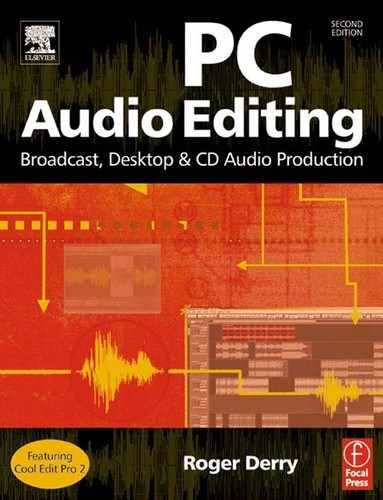2
Some technical bits
There are some technical terms that are much bandied about in audio. While it is possible to survive without a knowledge of them, they are a great help in making the most of the medium. However, you may wish to skip this chapter and read it later.
2.1 Loudness, decibels and frequencies
How good is the human ear?
Sound is the result of pressure – of compression/decompression waves travelling through the air. These pressure waves are caused by something vibrating. This may be something obvious, like the skin of a drum or the string and sounding board of a violin. However, wind instruments also vibrate; vibration may be caused by blowing through a reed or across a hole, and the turbulence causes the column of air within the pipe of the instrument to vibrate.
The two major properties that describe a sound are its frequency and its loudness.
Frequency
Frequency is a count of how many times per second the air pressure of the sound wave cycles from high pressure, through low pressure and back to high pressure again (Figure 2.1). This used to be known as the number of ‘cycles per second’, but has now been given a metric unit name; 1 hertz (abbreviation Hz) is one cycle per second. The hertz is named after Heinrich Hertz, who did fundamental research into wave theory in the nineteenth century.
The lowest frequency the ear can handle is about 20 Hz. These low frequencies are more felt than heard. Some church organs have a 16-Hz stop, which is added to other notes to give them depth. Low frequencies are the hardest to reproduce, and in practice most loudspeakers have a tough time reproducing much below 80 Hz.

Figure 2.1 Five cycles of a pure audio sine wave
At the other extreme, the ear can handle frequencies of up to 20 000 Hz, usually written as 20 kHz (kilohertz). As we get older our high frequency limit reduces, and this can happen very rapidly if the ear is constantly exposed to high sound levels.
The standard specification for high-fidelity audio equipment is that it should handle frequencies between 20 Hz and 20 kHz equally well. Stereo FM broadcasting is restricted to 15 kHz, as is the NICAM system used for television stereo in the UK. However, digital radio is not, and so broadcasters have begun to increase the frequency range required when programmes are submitted.
The frequencies produced by musical instruments occupy the lower range of these frequencies. The standard tuning frequency ‘middle A’ is 440 Hz, the ‘A’ one octave below that is 220 Hz, and an octave above is 880 Hz. In other words, a difference of an octave is achieved by doubling or halving the frequency.
Instruments also produce ‘harmonics’. These are frequencies that are multiples of the original ‘fundamental’ note. It is these frequencies, along with transients (how the note starts and finishes), that give an instrument its characteristic sound. This is often referred to as the timbre (pronounced ‘tam-ber’).
Loudness
Our ears can handle a very wide range of levels. The power ratio between the quietest sound that we can just detect – in a quiet, sound-insulated room – and the loudest sound that causes us pain is:
1 : 1 000 000 000 000
‘1’ followed by twelve noughts is one million million! To be able to handle such large numbers a logarithmic system is used. The unit, called a bel, can be thought of as a measure of the number of noughts after the ‘1’. In other words, the ratio shown above could also be described as 12 bels. Similarly, a ratio of 1 : 1000 is 3 bels, and a ratio of 1 : 1 – no change – is 0 bels. Decreases in level are described as negative, so a ratio of 1000 : 1 – a reduction in power of 1/1000th – is minus 3 bels.
For most purposes, the bel is too large a unit to be convenient. Instead, the unit used every day is one-tenth of a bel. The metric system term for one-tenth is ‘deci’, so the unit is called the ‘decibel’. The abbreviation is ‘dB’ – little ‘d’ for ‘deci’ and big ‘B’ for ‘bel’, as it is based on a person’s name; in this case Alexander Graham Bell, the inventor of the telephone and founder of Bell Telephones, who devised the unit for measuring telephone signals. Conveniently, a change of level of 1 dB is about the smallest change that the average person can hear (Table 2.1); also
Table 2.1 Everyday sound levels
| 0 dB | Threshold of hearing: sound-insulated room | |
| 10 dB | Very faint – a still night in the country | |
| 30 dB | Faint – public library, whisper, rustle of paper | |
| 50 dB | Moderate – quiet office, average house | |
| 70 dB | Loud – noisy office, transistor radio at full volume | |
| 90 dB | Very loud – busy street | |
| 110 dB | Deafening – pneumatic drill, thunder, gunfire | |
| 120 dB | Threshold of pain |
- 3 dB represents a doubling of power; 6 dB represents a doubling of voltage
- 10 dB increases sounds to twice as loud; –10 dB decreases sounds to be half as loud.
(Power equals Voltage × Current; double the voltage and you also double the current.)
2.2 Hearing safety
One of the hazards of audio editing on a PC is that it is often done on headphones in a room containing other people. Research has shown that people, on average, listen to headphones at 6 dB louder than they would to loudspeakers. So already they are pumping four times more power into their ears. When you are editing, there are going to be occasions when you turn up the volume to hear quiet passages and then forget to restore it when going on to a loud section. The resulting level into your ears is going to be way above that which is safe.
Some broadcasting organizations insist that their staff use headphones with built-in limiters to prevent hearing damage. By UK law, a sound level of 85 dBA is defined as the first action level (the ‘A’ indicates a common way of measuring sound-in-air level, as opposed to electrical audio decibels). You should not be exposed to sound at or above this level for more than 8 hours a day. If you are, as well as taking other measures, the employer must offer you hearing protection.
The second action level is 90 dBA, and at this noise level or higher ear protection must be worn, and the employer must ensure that adequate training is provided and that measures are taken to reduce noise levels as far as is reasonably practicable.
The irony here is that the headphones could be acting as hearing protectors for sound from outside, but themselves be generating audio levels above health and safety limits.
If you ever experience ‘ringing in the ears’ or are temporarily deafened by a loud noise, then you have permanently damaged your hearing. This damage will usually be very slight each time, but accumulates over months and years; the louder the sound, the more damage is done.
Slowly entering a world of silence may seem not so terrible, but if your job involves audio it will mean losing that job. Deafness cuts you off from people, and is often mistaken for stupidity. Worse, hearing damage does not necessarily create a silent world for the victim. Suicides have been caused by the other result of hearing damage, which is described by the medical profession as the gentle-sounding word ‘tinnitus’. This conceals the horror of living with loud, throbbing sounds created within your ear. They can seem so loud that they make sleep difficult. Some people end up in a nowin situation, where to sleep they have to listen to music on headphones at high level to drown the tinnitus. Of course, this in turn causes more hearing damage.
If you are reading this book then you value your ears – so please take care of them!
2.3 Analogue and digital audio
Analogue audio signals consist of the variation of sound pressure level with time being mimicked by the analogous change in strength of an electrical voltage, a magnetic field, the deviation of a groove, etc.
The principle of digital audio is very simple, and that is to represent the sound pressure level variation by a stream of numbers. These numbers are represented by pulses. The major advantage of using pulses is that the system merely has to distinguish between pulse and no-pulse states. Any noise will be ignored provided it is not sufficient to prevent that distinction (Figure 2.2).

Figure 2.2 Distinction between pulse and no-pulse states
The actual information is usually sent by using the length of the pulse; it is either short or long. This means that the signal has plenty of leeway in both the amplitude of the signal (how tall it is) and the length of the pulse. Well-designed digital signals are very robust, and can traverse quite hostile environments without degradation. However, this can be a disadvantage for, say, a broadcaster with a ‘live’ circuit, as there can be little or no warning of a deteriorating signal. Typically the quality remains audibly fine until there are a couple of splats, or mutes, then silence. Analogue has the advantage that you can hear a problem developing and make arrangements for a replacement before it becomes unusable.
Wow and flutter are eliminated from digital recording systems, along with analogue artefacts such as frequency response and level changes. If the audio is copied as digital data, then it is a simple matter of copying numbers and the recording may be ‘cloned’ many times without any degradation. (This applies to pure digital encoding; however, many modern systems, such as Minidisc and Digital Radio and Television, use a ‘lossy’ form of encoding. This throws away data in a way that the ear will not usually notice. However, multi-generation copies can deteriorate to unusability within six generations, especially if different forms of lossy compression are encountered. Even audio CD and DAT are lossy to some extent, as they tolerate and conceal digital errors.)
What is digital audio?
Pulse and digital systems are well established, and can be considered to have started in Victorian times.
Perhaps the best known pulse system is the Morse code. Like much digital audio, this code uses short and long pulses. In Morse, these are combined with short, medium and long spaces between pulses to convey the information. The original intention was to use mechanical devices to decode the signal, but in practice it was found that human operators could decode by ear faster.
Modern digital systems run far too fast for human decoding, and adopt simple techniques that can be dealt with by microprocessors with rather less intelligence than a telegraph operator. Most systems use two states that can be thought of as on or off, short or long, dot or dash (some digital circuits and broadcast systems can use three or even four states, but these systems are beyond the scope of this book).
The numbers that convey the instantaneous value of a digital audio signal are conveyed by groups of pulses (bits) formed into a digital ‘word’. The number of these pulses in the word sets the number of discrete levels that can be coded.
The word length becomes a measure of the resolution of the system and, with digital audio, the fidelity of the reproduction. The compact disc uses 16-bit words giving 65 536 states. NICAM stereo, as used by UK television, uses just 10 bits, but technical trickery gives a performance similar to 14-bit. Audio files used on the Internet are often only 8-bit in resolution, while systems used for telephone answering etc. may only be 4-bit systems or less (Table 2.2).
Table 2.2 Table showing how many discrete levels can be handled by different digital audio resolutions
| 1-bit = 2 | 7-bit = 128 | 13-bit = 9192 | 19-bit = 524 287 |
| 2-bit = 4 | 8-bit = 256 | 14-bit = 16 384 | 20-bit = 1 048 575 |
| 3-bit = 8 | 9-bit = 512 | 15-bit = 32 768 | 21-bit = 2 097 151 |
| 4-bit = 16 | 10-bit = 1024 | 16-bit = 65 536 | 22-bit = 4 194 303 |
| 5-bit = 32 | 11-bit = 2048 | 17-bit = 131 071 | 23-bit = 8 388 607 |
| 6 bit = 64 | 12-bit = 4096 | 18-bit = 262 143 | 24-bit = 16 777 215 |
The larger the number, the more space is taken up on a computer hard disk or the longer a file takes to copy from disk to disk or through a modem. Common resolutions are: 8-bit, Internet; 10-bit, NICAM; 16-bit, compact disc; 18–24-bit, enhanced audio systems for production. Often, 32-bit is used internally for processing to maintain the original bit-resolution when production is finished.
Sampling rate
A major design parameter of a digital system is how often the analogue quantity needs to be measured to give accurate results. The changing quantity is sampled and measured at a defined rate.
If the sampling rate is too slow, then significant events may be missed. Audio should be sampled at a rate that is at least twice the highest frequency that needs to be produced. This is so that, at the very least, one number can describe the positive transition and the other the negative transition of a single cycle of audio. This is called the Nyquist limit after Harry Nyquist of Bell Telephone Laboratories, who developed the theory.
For practical purposes, a 10 per cent margin should be allowed. This means that the sampling rate figure should be 2.2 times the highest frequency, and as 20 kHz is regarded as the highest frequency that most people can hear, this led to the CD being given a sampling rate of 44 100
samples a second (44.1 kHz). The odd 100 samples per second is a technical kludge. Originally digital signals could only be recorded on videotape machines, and 44.1 kHz will fit into either American or European television formats.
The sampling process must be protected from out-of-range frequencies. These ‘beat’ with the sampling frequency and produce spurious frequencies that not only represent distortion but also, because of their non-musical relationship to the intended signal, represent a particularly nasty form of distortion. These extra frequencies are called alias frequencies, and the filters called anti-aliasing filters. It is the design of these filters that can make the greatest difference between the perceived quality of analogue to digital converters. You will sometimes see references to ‘over-sampling’; this technique emulates a faster sampling rate (4×, 8×, etc.), and simplifies the design of the filters.
Errors
A practical digital audio system has to cope with the introduction of errors, owing to noise and mechanical imperfections, of recording and transmission. These can cause distortion, clicks, bangs and dropouts when the wrong number is received.
Digital systems incorporate extra ‘redundant’ bits. This redundancy is used to provide extra information to allow the system to detect, conceal or even correct the errors. Decoding software is able to apply arithmetic to the data, in real time, so it is possible to use coding systems that can actually detect errors.
However, audio is not like accountancy, and the occasional error can be accepted, provided it is in a well-designed system where it will not be audible. This allows a simpler system (using less redundant bits) to be used to increase the capacity, and hence the recording length, of the recording medium. This is why a CDR burnt as a computer CD-ROM storing wave file data has a lower capacity than the same CDR using the same files as CD-audio. CD-ROMs have to use a more robust error correction system, as NO errors can be allowed. As a result, a standard CDR can record 720 Mbytes of CD audio (74 minutes) but only 650 Mbytes of computer data.
Having detected an error, a CD player may be able to:
- Correct the error (using the extra ‘redundant’ information in the signal)
- Conceal the error, which is usually done either by sending the last correctly received sample (replacement) or by interpolation, where an intermediate value is calculated
- Mute the error – a mute is usually preferable to a click.
While the second and third options are good enough for the end product used by the consumer, you need to avoid the build-up of errors during the production of the recording. Copies made on hard disk, internally within the computer, will be error-free. Similarly, copies made to CD-ROM or to removable hard disk cartridge will also have no errors (unless the disk fails altogether because of damage).
Multi-generation copies made through the analogue sockets of your sound card will lose quality. Copies made digitally to DAT will be better, but still accumulate errors. However, a computer backup as data to DAT (4 mm) should be error-free (as should any other form of computer backup medium. These have to be good enough for accountants, and therefore error-free).
How can a computer correct errors?
It can be quite puzzling that computers can get things wrong but then correct them. How is this possible? The first thing to realize is that each datum bit can only be ‘0’ or ‘1’. Therefore, if you can identify that a particular bit is wrong, you know the correct value – if ‘0’ is wrong then ‘1’ is right, and if ‘1’ is wrong then ‘0’ is right.
The whole subject of error correction involves deep mathematics, but it is possible to give an insight into the fundamentals of how it works. The major weapon is a concept called parity. The basic idea is very simple but, suitably used, can become very powerful. At its simplest this consists of adding an extra bit to each data word, and this bit signals whether the number of ‘1’s in the binary data is odd or even. Both odd and even parity conventions are used. With an even parity convention the parity bit is set so that the number of ‘1’s is an even number (zero is an even number), and with odd parity the extra bit is set to make the number of ‘1’s always odd.
Received data are checked during decoding. If the signal is encoded with odd parity and arrives at the decoder with even parity, then it is assumed that the signal has been corrupted. A single parity bit can only detect an odd number of errors.
Quite complicated parity schemes can be arranged to allow identification of which bit is in error, and for correction to be applied automatically. Remember that the parity bit itself can be affected by noise.

Figure 2.3 A method of parity checking a 16-bit word by using 8 extra parity bits
Figure 2.3 illustrates a method of parity checking a 16-bit word by using eight extra parity bits. The data bits are shown as ‘b’, the parity bits are shown as ‘P’.
The parity is assessed both ‘vertically’ and ‘horizontally’. The data are sent in the normal way, with the data and parity bits intermingled. This is called a Hamming code. If the bit in the second column, row two were in error, its 2 associated parity bits would indicate this. As there are only two states, if the bit is shown to be in error then reversing its state must correct the error.
Dither
The granular nature of digital audio can become very obvious on low-level sounds such as the die-away of reverberation or piano notes. This is because there are very few numbers available to describe the sound, and so the steps between levels are relatively larger as a proportion of the signal.
This granularity can be removed by adding random noise, similar to hiss, to the signal. The level of the noise is set to correspond to the ‘bottom bit’ of the digital word. The frequency distribution of the hiss is often tailored to optimize the result, giving noise levels much lower than would be otherwise expected. This is called ‘noise-shaping’. PC audio editors often have an option to turn this off, but don’t do this unless you know what you are doing. Dither has the almost magical ability to enable a digital signal to carry sounds that are quieter than the equivalent of just 1 bit.
2.4 Time code
All modern audio systems have a time code option. With digital systems, it is effectively built in. At its simplest level, it is easy to understand; it stores time in hours, minutes and seconds. As is so often the case, there are several standards.
The most common audio time display that people meet is on the compact disc; this gives minutes and seconds. For professional players, this can be resolved down to fractions of second by counting the data blocks. These are conventionally called frames, and there are 75 every second. This is potentially confusing, as CDs were originally mastered from three-quarter-inch U-Matic videotapes where the data were configured to look like an American television picture running at 30 video frames per second (fps).
In 1967, the Society of Motion Picture and Television Engineers (SMPTE) created a standard defining the nature of the recorded signal and the format of the data recorded. This was for use with videotape editing. Data are separated into 80-bit blocks, each corresponding to a single video frame. The way that the data are recorded (Biphase modulation) allow them also to be read from analogue machines when the machines are spooling at medium speed, with the tape against the head, in either direction. With digital systems, the recording method is different but the code produced stays at the original standards.
There are three common video frame standards; 25 fps (European TV), 30 fps (American) and, for technical reasons, a more complicated format known as 30 fps drop frame, which corresponds to an average to 29.97 fps.
By convention, on analogue machines the highest numbered track is used; track 4 on a 4-track; track 16 on a 16-track, etc. It is a nasty screeching noise best kept as far away from other audio as possible.
Time code can also be sent to a sequencer (via a converter) as MIDI data, allowing the sequencer to track the audio tape. The simple relationship between bars, tempo and SMPTE time as shown by sequencers like Cubase is only valid for 120 beats per minute 4/4 time. MIDI time code generators need to be programmed with the music tempo and time signature used by the sequencer, so they can operate (in a gearbox fashion) so that the sequencer runs at the proper tempo.
People editing audio for compact disc will often prefer to set the time display to 75 fps to match the CD data. There is a small technical advantage to ensuring that an audio file intended for CD ends exactly at the frame boundary, as there are occasions when not doing so will cause a click.

Figure 2.4 Right clicking on Cool Edit’s time display provides a wide range of options for the frame display
Right-clicking on Cool Edit’s time display provides a pop-up with a wide range of options for the frame display (Figure 2.4), including being able to match to the bars and beats of a MIDI track.
See Appendix 1 for more information on time code.
